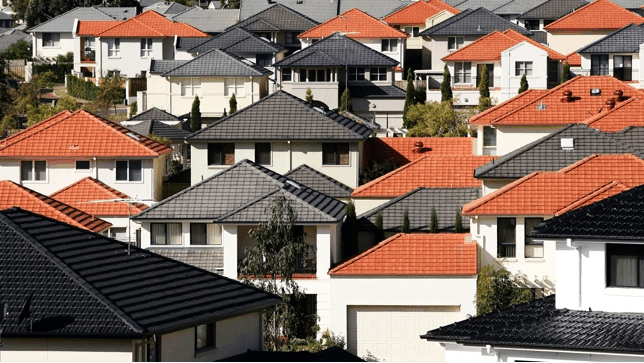
The Australian Bureau of Statistics (ABS) yesterday released its biennial Housing Occupancy and Costs Survey for 2011-12, which provided some interesting insights, including the sharp fall in homeownership since 1994-95, from 71% to 67%.
Sydney University housing expert, Judy Yates, attributes the slide in home ownership to declining affordability and increasing investor participation:
”This is all about affordability,” she said.
But Associate Professor Yates said the decline in the share of outright home owners was also being driven by well-established families using their mortgages to fund other purchases, especially investment properties.
Below are key extracts from the ABS Survey:
Housing Occupancy:
According to the ABS, there were approximately 22.2 million people, or 8.6 million households, living in private dwellings in Australia in 2011-12, up 26% on the number of people in private dwellings in 1994-95. There was an increase in the number of households over this period (up 32%) and a decrease in the average household size from 2.7 to 2.6 persons per household. The average dwelling size increased over this period from 2.9 to 3.1 bedrooms per dwelling (see next chart).
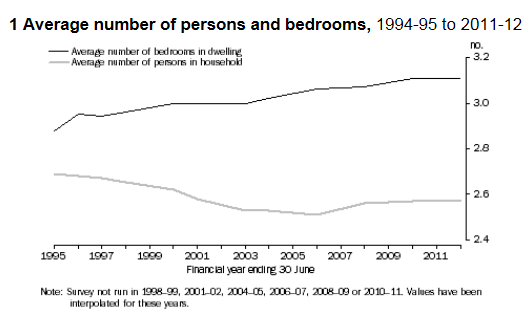
The proportion of Australian households that own their own home with or without a mortgage has declined from 71% in 1994-95 to 67% in 2011-12. Over this period there was a decrease in the proportion of households that owned their dwelling outright, from 42% in 1994-95 to 31% in 2011-12. There were increases in the proportion of households that owned their dwelling with a mortgage (from 30% to 37%) and in the proportion of households that were renting privately (from 18% to 25%):
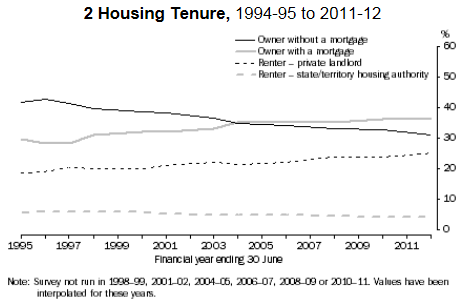
Housing Utilisation:
Households who owned their home without a mortgage were more likely than those with other tenures to have one or more bedrooms spare (90%). Households renting from a state or territory housing authority were the most likely tenure group (45%) to have only the required number of bedrooms. Six percent of private renters required one or more additional bedrooms (see next chart).
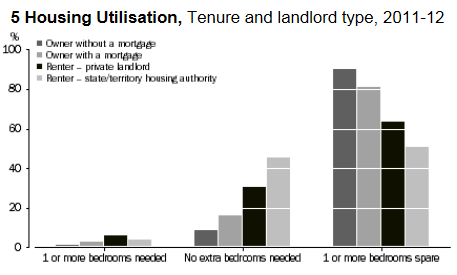
Sixty-seven percent of couples living with dependent children had at least one spare bedroom, compared to 48% of one parent households with dependent children. Of the latter group, 11% required one or more additional bedrooms. Multiple family households were the most likely to require additional bedrooms (22%). On average, dwellings for couples with dependent and non-dependent children contained the highest number of bedrooms (3.9) and housed an average of 4.7 people.
Housing Costs:
Between 1994-95 and 2011-12, private renters experienced a 57% (or $126) increase in average weekly housing costs, after adjustment for inflation. For other tenure types, there was an overall increase of 43% (or $129) for owners with a mortgage and 40% (or $39) for public renters (table 1).
For owners with a mortgage and private renters, the proportion of income spent on housing costs in 2011-12 is the same as in 1994-95, at 18% and 20% respectively.
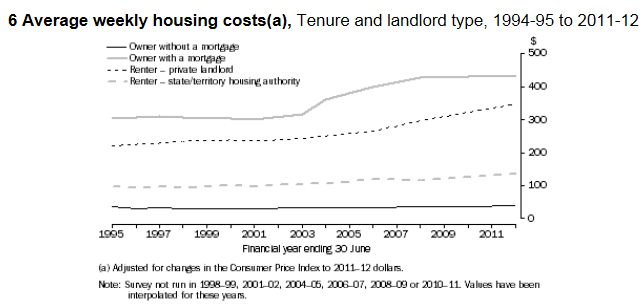
Value of Dwelling:
In 2011-12, the median value of the 5.8 million owner occupied dwellings was $450,000, a decrease of 3% on the CPI adjusted value of $464,000 in 2009-10, and a 104% increase on the corresponding value in 1994-95 (table 1). The CPI adjusted value of the median mortgage outstanding increased by 5% between 2009-10 and 2011-12 (from $190,000 to $200,000), and increased by 124% between 1994-95 and 2011-12.
The median value of dwellings in Australian capital cities was $500,000 in 2011-12. The median value in Sydney ($600,000) and Canberra ($550,000) were above the national capital city average. Adelaide ($425,000) and Hobart ($400,000) had median dwelling values below the national capital city average (see next chart).
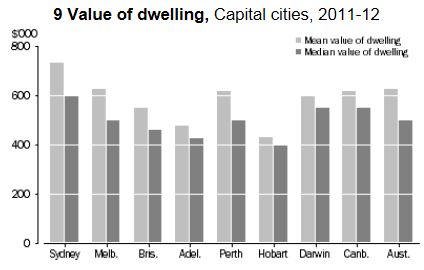
Recent Home Buyers:
In 2011-12, approximately 988,000 households purchased their dwelling in the three years prior to the survey, down from 1,073,800 in 2009-10. These households are divided into first home buyers (36%) and changeover buyers (64%). Most first home buyers were young households with a reference person aged under 35 years (65%). Only 11% of first home buyer households had a reference person aged 45 years and over. In contrast, 52% of changeover buyer households had a reference person aged 45 years and over.

The median value of recently purchased dwellings was $370,000 for first home buyers and $500,000 for changeover buyers (table 34). New dwellings purchased by recent home buyers had a higher median value ($500,000) than established dwellings purchased by recent home buyers ($420,000) (table 34).
Average housing costs for first home buyers and changeover buyers were $470 and $443 per week respectively (table 32). This is consistent with a higher proportion of first home buyers having a mortgage (94%) than for changeover buyers (74%).
First home buyers with a mortgage:
Couple families with dependent children and couple only households made up the majority (65%) of first home buyers with a mortgage, with 47% of these couple households including dependent children. A further 22% were lone person households. There has been little change in the family composition of first home buyer households since 1995-96.
In 2011-12, first home buyers with a mortgage lived in smaller dwellings, on average (3.0 bedrooms), than either change over buyers (3.3 bedrooms) or all owner households (3.3 bedrooms).

